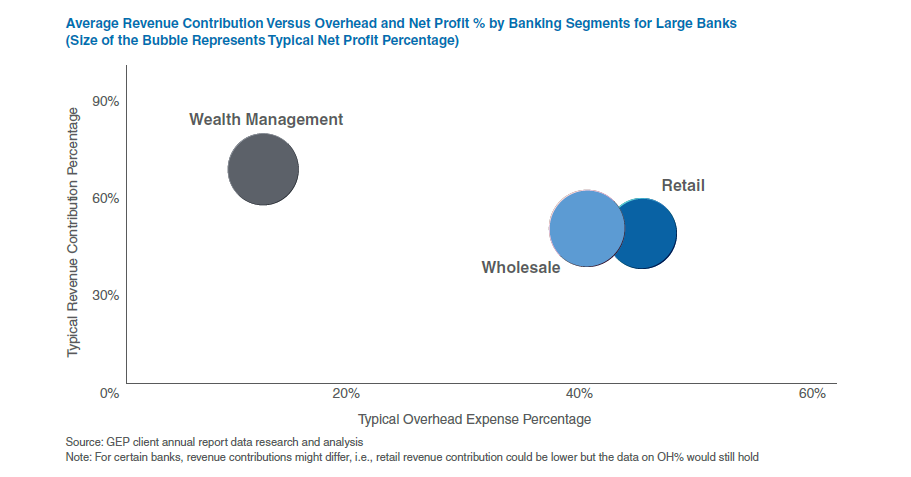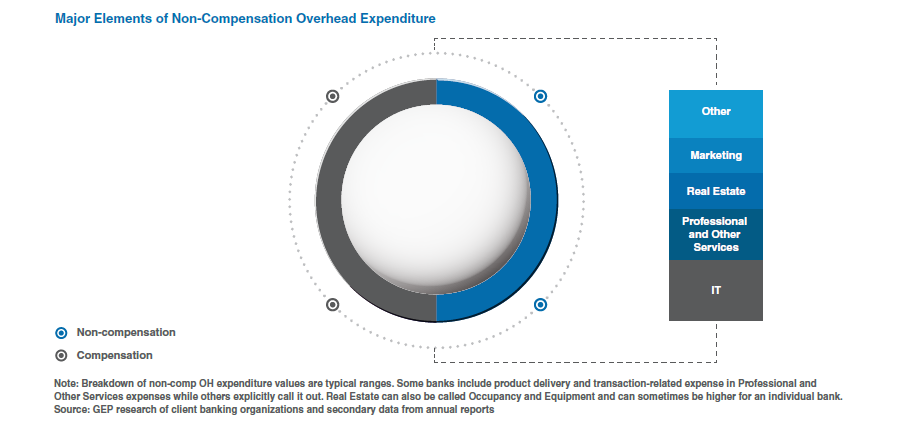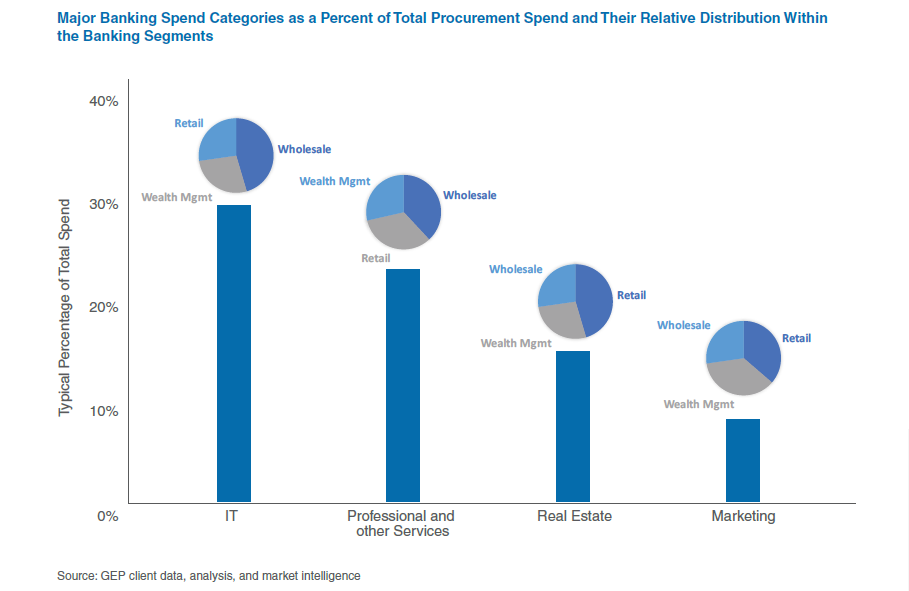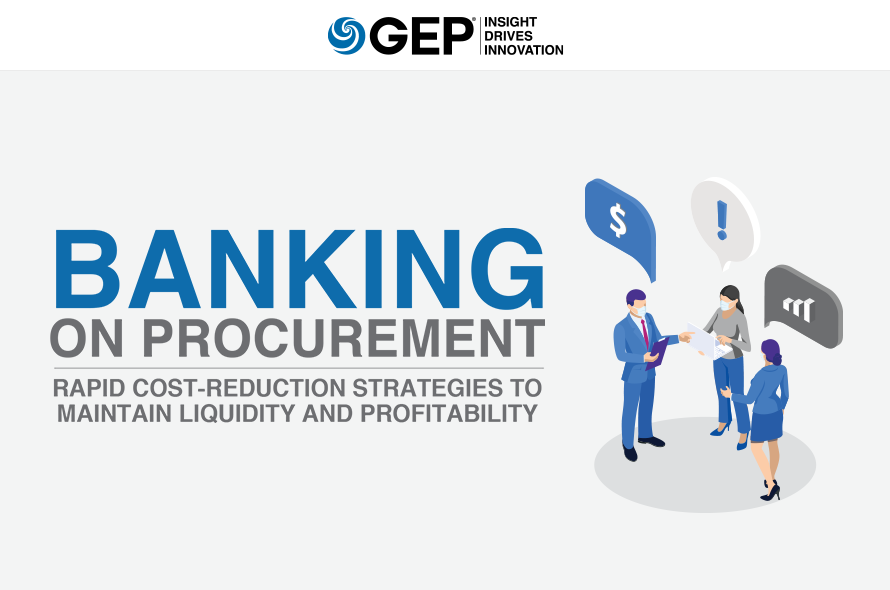With the current pandemic, the pressure on profits in retail, wholesale and wealth management banking services is massive for the foreseeable future.
The latest GEP white paper, Banking on Procurement: Rapid Cost-Reduction Strategies to Maintain Liquidity and Profitability, offers detailed directives to help ensure the right cost decisions are made — and the right strategic customer-facing decisions are upheld.
What’s Inside:
- How to drive down purchasing costs
- How to use “stop spending/smart spending” measures effectively
- How to actively manage risk and customer loyalty with technology
This white paper is a must-read for procurement leaders in banking who need to plan beyond the present.
The unfortunate coronavirus (COVID-19) outbreak has impacted the financial market globally. With an impending recession on the horizon, banks are the most affected since they are the medium through which money flows.
The following paper is an in-depth look at the banking industry for the remainder of 2020 — with a focus on the impact for retail, wholesale and wealth management banking services.
OUR TAKE

Cost cutting is a strategic imperative in chaotic economic times and can help companies rebound more rapidly. We say “can help” because it only happens with a proactive management approach.
GEP believes that most banks’ typical overhead ratio of 55%+ will become adversely impacted as net interest income and other noninterest income takes a dip because of prevailing market conditions — and because banks generally do not take adequate measures to reduce operating expenses. We also believe that procurement is a very good area for banks to evaluate since procurement costs can easily be 30% to 50% of a bank’s operating expense.
Banks can drive reduction in near-term operating expense by:
1. Driving down purchasing costs
2. Implementing “stop spending/smart spending” measures to actively manage demand and allocate resources commensurate with returns
3. Actively managing operational risks
It is also crucial, given the asset sensitivity in this industry, that banks are able to preserve customer loyalty through this period of tough business conditions. Their ability to do so will have a bearing on:
a. Digital capability
b. Leadership position in the cloud and mobility space
c. Technological innovation in the areas of artificial intelligence, machine learning and blockchain to continuously improve efficiency
Procurement has a large role to play to help manage strategic vendor relationships, foster supplier-led innovations and ensure that there is close alignment between procurement and the business strategy to drive the initiatives forward.
HOW WE GOT HERE
According to our analysis of recent equity market data from March 2020, banks are down ~-34%, insurance ~-26% and diversified financials ~13% from a year ago. A global consumer default wave has started in China where COVID-19 first surfaced. Early indicators show a surge in past due loans; credit card debt swelled 50% from 12 months ago and in February China lost an estimated 8 million jobs, according to published data. In today’s highly connected global economy, the pain is likely to spread as unemployment rises across the world.

As COVID-19 has worked its way through the rest of Asia, Europe and, especially, the United States, it has forced countries into lockdowns, driving up unemployment and pummeling small-business owners in spite of the U.S. President’s trillions of dollars’ worth of financial aid passed through the Congress. Over the last several weeks, nearly 26 million Americans filed for unemployment benefits, and it’s probably only a matter of time before stretched households start to default on their loans globally.
While the extent of the squeeze on consumers and their lenders will depend on the continued effectiveness of government efforts to contain the virus and shore up economies, the scope for pain in banking is immense.
BANKING LIQUIDITY AND PROFITABILITY DURING COVID-19 AND AFTER
Looking directly at current business conditions with COVID-19 and beyond, it is important to understand the fundamental differences between a bank’s different business segments, cost structures and challenges to liquidity and profitability. Broadly speaking, a large bank’s typical major segments includes:
- Retail banking, which involves deposits, mortgages, loans and credit cards
- Wholesale banking, which involves commercial banking, investment banking, treasury and security services
- Wealth management, which involves retail brokerage services and asset management
Please note that some banks’ overhead ratio by the different banking segments paints a different picture that refers to general profitability of each segment (please see figure below):

While different segments of a bank have different overhead ratios, major elements of overhead expenditure still apply (please see figures below):

The major elements of expenditure almost directly translate to procurement categories in the same proportion of spend and consequently provide opportunities for operating cost reduction for all banking segments — some more than others (please see figure below):

Please note that the applicability of the spend category to banking segments, i.e., the pie charts is only a directional representation intended to help uncover shadow and/or maverick spend within business units and/or segments. The weightings are common ranges observed in business unit spend by GEP clients over our 20-year history. Later in this document we will review some additional categories and associated procurement strategies for each category.
Let’s take a look at the rating system to assess performance, now that we know that each segment can have very different revenue, profitability and overhead contributions and are susceptible to different levelsof market volatility and liquidity.
| Component | Ratio | High-quality Rank (Value) |
| Capital Adequacy | Equity Capital / Total Assets | 11% |
| Asset Quality | Non-performing loans / Total loans | < 1.5% |
| Management Quality | Personnel Expense /Average Assets | < 25% |
| Earnings Quality |
| > 1.5% > 22% |
| Liquidity Coverage Ratio (LCR) | Asset that can be Easily Converted to Cash / Total Net Cash Flow Amount | Enough high-quality liquid assets to fund cash outflows for 30 days |
The Liquidity Coverage Ratio, or LCR, is aimed at anticipating marketwide shocks and making sure that banks possess suitable capital to ride out any short-term liquidity problems. Banks sometimes can also use an operating cash flow ratio to measure how well current liabilities are covered with cash flow from operations.
Nonetheless, under current conditions banks are feeling stress across segments and units. There are several distinct reasons for this environment. In the retail segment, for example:
1. Drops in loan repayments due to a moratorium provided on loans by governments in many countries or simply due to defaults, hence reducing inflows.
2. The drawdown of committed lines by corporations to fund working capital needs leads to higher outflows.
3. The need to lend to corporates for working capital even in the absence of committed lines to help them get through this stressful economic environment and hence protect their creditworthiness.
4. Most banks are being forced to waive interest charges and there is generally lower consumer spending in the retail business.
The wealth management segment is also starting to take a hit in countries as fee income falls and there is decreased asset under management as investors flee to safety. The state of the equity markets will also cause reduction in trading fees. The wholesale/commercial banking segment is witnessing decreased investment-banking activity and, consequently, experiencing lower commissions. Commercial banking will also see increased credit losses across most industry sectors. Last but not the least, remote work will increase costs and operational losses will expand as fraud increases.
Simultaneously, there will be a depletion in sources to generate enough liquidity to meet the enhanced borrowing requirements. Deposits, for example, may go up for large, credible too-big-to-fail banks as investors flee equity markets and other investments toward safer options such as cash. At the same time, however, lower-rung banks may see deposit withdrawals due to the low risk appetite of consumers in uncertain times. Net interest margins will remain low or fall further.
Regulators in several countries and geographies understand the challenge and are relaxing rules for banks. Temporarily, banks are allowed to operate below liquidity coverage ratio providing repo funding to buy a variety of securities. Capital requirements are also being relaxed.
Even with respite from the regulators, it will be difficult for banks to maintain liquidity and remain profitable if the crisis continues for months. They will have to look at reducing costs.
PROCUREMENT COST LEVERS TO PULL IN BANKING
Retail banking
In retail banking, for example, many branches are starting to operate curtailed hours or shutting down considering drop in customer demand.
Retail banking costs can benefit from:
- Curtailing hours of operation
- Reducing temporary labor
- Reducing utility cost
- Making cash operations lean (cash distribution centers and branches)
- Pooling resources with other banks to form a shared cash handling system
Most banks can reduce their cash costs by eliminating waste and maximizing productivity in distribution centers, inventory management and transportation. They could also benefit from optimizing call center operations through automated workforce scheduling, improved first-call resolution procedures, workstation sharing and more.
Wholesale banking
In wholesale banking, investment in technology and products is a competitive advantage to bring data, insights to clients as well as to identify new customers at a national level in new markets. That said, in the current business situation, every investment should be reviewed and approved. Cost savings measures can include:
- Stopping discretionary IT investments and reviewing demand reduction, vendor optimization and labor optimization opportunities.
- Comprehensive review of IT expenditures can help reduce demand and deliver 5% to 10% savings in the near to mid term. Examples include reducing service levels to match demand and non-value-added service, executing only those projects directly linked to bank’s strategic objectives purging historic data, reducing license usage, etc.
- Vendor optimization – Move vendors to alternative pricing models, such as, performance-based pricing, renegotiating pricing and consolidating relationships.
- Using stop-spending levers for any facilities— including upgrades and maintenance
- Review data and subscriptions charges
From the cost reduction measures above within each banking segment, we conclude that there is commonality of procurement categories to be used with selective levers to achieve quick wins.
The table below shows categories suitable for cost reduction during the COVID-19 crisis and beyond — and the impact they can make. The level of impact has correlation with the percentage of spend contribution of the category against the total spend.
| Category | Typical sub-categories | Suitability for rapid procurement cost reduction during COVID-19 phase | Impact | Typical strategy |
| Real estate | Lease / rents; Facility layout; Building maintenance | High | High |
|
| IT / Telecom | SW, HW; Infrastructure services; Data servers; App dev support and maintenance; Network and telecom | Medium | High |
|
| Professional services | Consulting; Legal fees; Workforce management | High | Medium |
|
| Marketing | Creative; Digital; Merchandise; Market research | High | Medium |
|
| Financial services and operations | Contact center; Credit card and lending services; | Medium |
| |
| Travel expenses | Air; Train; Rental cars | High | Medium – Low |
|
| Cash management and ATM | Equipment; Transportation; Spare parts | High | Low |
|
| HR | Learning and development; Employee benefits | High | Low |
|
More broadly, many suppliers in certain industries segments are benefitting from lower input costs, such as from lower oil prices. The time is ripe for procurement and business to ask suppliers to pass on the cost reductions. The outreach for this ask should be broad and not just limited to tier-1 suppliers. Additionally, to reduce cost of production procurement should look at savings generated by direct cost cutting measures that could be quick wins.
Additionally, optimizing supplier payments should be part of the broader strategy of focusing on cash conversion cycle. Procurement can help optimize supplier payment terms (days payable outstanding) by lengthening credit terms and stopping early terms.
Last but not the least, spending plans should be reviewed often to put a stop to all discretionary investments if COVID-19 adversely influences investment returns and to defer those expenses that can be avoided. To preserve cash, procurement should implement spend-specific control towers to “spend better,” aligning resources to high-value spend areas and increase transparency in spending patterns.
In addition to driving reduction in purchasing costs and driving stop spending/smart spending measures, banks should continuously monitor risks.

A large bank will typically classify four types of risks including:
- Strategic risk
- Credit and investment risk
- Market risk
- Operational risk
Procurement lends itself to operational risk — the risk that is associated with failed internal processes, systems or external events and includes compliance, conduct and/or legal risk. Here’s where GEP’s third-party risk management offering comes into play, which we assess, implement and monitor very successfully at several of our financial services clients, including banking, insurance and diversified financials through a combination of services, control tower and technology platform.
PREPARING FOR THE RECOVERY
Here’s how to prepare for what lies ahead after COVID-19, such as maintaining market share and keeping a competitive advantage. GEP advises:
1. Latch onto the cloud. If you’re not there yet, prepare yourself to take the leap
Cloud provides rapid scale, simplified implementation and elasticity of computing power beyond your infrastructure. It provides clean, accurate and integrated data sets, off-the-shelf analytics platforms and machine learning capabilities.
2. Make sure that you are leveraging the power of artificial intelligence for both effectiveness and efficiency
Deep learning, for example, leverages machine learning in investment banking to optimally execute over 1,000 equity transactions per day across the globe. Robots driven by AI maintain internal helpdesks and track down human errors. Numerous commercial-off the-shelf solutions help in better underwriting and expediting mortgage applications. In customer operations, AI helps ATM cash management by optimizing cash in devices, reducing cost of reloads and scheduling machine maintenance.
3. Manage your risks. Threats to cybersecurity may be the biggest threat to the U.S. financial system
Do you feel comfortable that you are adequately prepared to thwart becoming a target of fraud and manipulation? The rise of ransomware, data theft and bad actors inside and outside of your organization, including third parties, are an ever-expanding threat vector that needs to be managed proactively.
4. Manage overhead expenses, ensure liquidity and control asset risk
Bring expenses in-line top-line using viable short-term cost reduction measures without losing sight of the future. Leverage real-time data, insights and analytics to continuously monitor liquidity in the system and asset risk from customers and markets and act decisively
Procurement has a critical role to play to ensure all of the above — in coordination with the banking system’s corporate technology function — that the right vendor is selected, the right KPIs are in place to achieve performance, and the right innovation, tools and technologies are leveraged while building the optimal level of strategic supplier relationship.
RAPID RESPONSE SOLUTIONS FROM GEP
As the coronavirus crisis intensifies, managing your supply chain is going to get even more challenging. It may be worth finding a partner with deep experience in procurement and supply chain management to reinforce your capabilities and help you stay on course.
If you would like to have a conversation about how we can help, please reach out to our supply chain leadership.

John Piatek
Vice President, Consulting
John has over 15 years of strategy consulting experience managing several large-scale engagements with leading global clients.
At GEP, John is responsible for partnering with leading CPG and retail enterprises on strategy, supply chain and management initiatives. John is also the Chair of GEP’s Thought Leadership Council.











